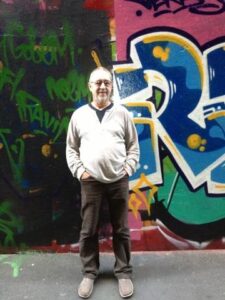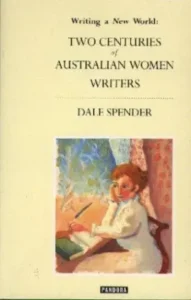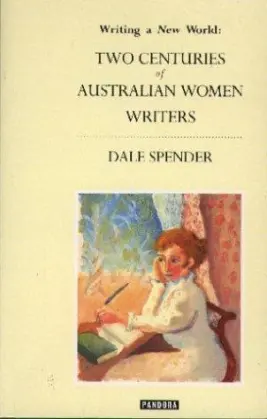by Bill Holloway
 The New Woman movement bloomed in Anglophone writing in the 1890s; was influential up to the Second World War; was forgotten during the ‘white picket fence’ 1950s; and then its ideas, if not its memory, were taken up again by second wave feminism, Women’s Lib, in the 1960s and 70s.
The New Woman movement bloomed in Anglophone writing in the 1890s; was influential up to the Second World War; was forgotten during the ‘white picket fence’ 1950s; and then its ideas, if not its memory, were taken up again by second wave feminism, Women’s Lib, in the 1960s and 70s.
I have written about the New Woman before, its slow growth from the philosophical writings of Mary Wollstonecraft and of Harriet and JS Mill; through the 1850s and Charlotte and Anne Brontë; to its wide acceptance in the 1890s coinciding with the movement for women’s suffrage. The ideas were as prevalent here as elsewhere, perhaps even more so, given the excitement and egalitarianism associated with the new nationalism and the movement towards Federation.
It is not possible to write about early Australian women writers without mentioning, and relying on, the work of Dale Spender, in particular, Writing a New World – Two Centuries of Australian Women Writers (1988), and her being almost single-handedly responsible for the republication – through Penguin and Pandora – of some of our best early Australian novels after they had been disregarded by the literary establishment, and out of print for the best part of a century.
Spender wrote that the neglect of women’s writing arose because
their concerns, their views and values are not those of men. It was men who early took charge of the Australian world of letters; it was they who became the gatekeepers in universities and publishing houses and on literary pages; it was (and is) mainly men who have controlled the entry of contributions to the cultural heritage. And they have elected to praise, preserve and transmit to the next generation, the achievements of men.
 She goes on to say that Ada Cambridge, Tasma (Jessie Couvreur) and Rosa Praed “became best-selling novelists in Australia, Britain and the United States and, were the image of Australia to be drawn from their writings rather than those of a few men, the representation of Australia, past and present, would be very different.”
She goes on to say that Ada Cambridge, Tasma (Jessie Couvreur) and Rosa Praed “became best-selling novelists in Australia, Britain and the United States and, were the image of Australia to be drawn from their writings rather than those of a few men, the representation of Australia, past and present, would be very different.”
.
Here is an overview of the first generation of Australian women novelists.
Catherine Helen Spence (1825-1910)
By the time she was writing her autobiography in 1910, Catherine Helen Spence recognised that her life and work were situated within the New Woman movement; and indeed Clara Morison which came out in 1854, seven years after Jane Eyre, is an important starting point, in Australia, for the idea of women rating careers ahead of marriage (though of course, both eponymous heroines do eventually marry).
Spence, who stayed unmarried throughout her own life, investigates again the idea of young middle class women being left to support themselves in Mr Hogarth’s Will (1865).
Around 1880, her ‘utopian’ novel Handfasted – A Romance (not published until 1984) was submitted to the Sydney Mail for a competition, but was rejected as ‘calculated to loosen the marriage tie … too socialistic and therefore dangerous’.
Louisa Atkinson (1834-1872)
Atkinson’s Gertrude the Emigrant: A Tale of Colonial Life (1857) is the first novel whose author was born in Australia (in the NSW Southern Highlands). Gertrude, 19, well educated, is selected off the boat on her arrival in Sydney by the wealthy landowner Mrs Doherty, to be her housekeeper companion. Mrs Doherty is clearly financially independent, though Atkinson chooses to have her reliant on her foreman or “superintendent”. Gertrude is more than competent at supporting herself; is interested in Australian life and in particular, the Aboriginal people living and in some cases working, on the properties she’s on; but her clear objective is to make a sensible marriage.
Atkinson wrote a second novel, but like Charlotte Brontë, she married late and died in childbirth.
Ada Cambridge (1844-1926)
Ada Cambridge was the wife of an Anglican vicar who had a number of postings around Victoria, ending up in Williamstown where she is still remembered. She wrote 25 novels of which I have read two or three, plus her memoir. Her young women often form their own households, but they are invariably living on inheritances and seeking husbands. Interestingly, in a later novel, Sisters (1904), amongst a lot of marriages, the most unsatisfactory is to an Anglican vicar.
Tasma (Jessie Couvreur) (1848-1894)
Jessie grew up In Hobart and was if not well educated (it’s not recorded) was at least well read. She married at 18, in 1867 to Victorian ‘gentleman’ Charles Fraser who was 8 years older, and worked for his brother in law in Kyneton and Malmsbury.
Fraser was unfaithful and soon had one of the servants pregnant. Jessie left him, went to Europe with her mother, came back after several years, lived separately from Fraser, began writing, adopted the pen-name Tasma in 1877, went back to Europe where she remained – after a brief return to Melbourne to obtain a divorce – married to Belgian politician, Auguste Couvreur.
After her first and best known work, Uncle Piper of Piper’s Hill (1889) – for which I will post a review next week – her subsequent novels were in large measure attacks on her former husband and on the institution of marriage.
Catherine Martin (1848-1937)
Catherine Martin was born in Scotland, coming out to South Australia with her parents when she was seven, living and later teaching in Mt Gambier and becoming proficient in German and well read in German literature. She tried journalism and for several unhappy years, being a clerk in the Education Dept in Adelaide before marrying in 1882 Frederick Martin, an accountant and writer.
A Unitarian (as well as a Scot) like Catherine Helen Spence, they became friends. Martin’s first novel An Australian Girl came out anonymously in 1890 and was well received. I quite often have it among my 10 best Australian books.
The main character, Stella Courtland, is a young woman, a lapsed Catholic, educated and thoughtful, living with her well-off widowed mother in Adelaide in the 1880’s, mixing socially with both the squattocracy and her late father’s cultured German friends (there was a large German community in Adelaide and south-eastern South Australia). She is wooed constantly by Ted Ritchie, a rich young squatter, and, in fact, they had been engaged, briefly, some years before the book begins. Stella is distinctly ambivalent about marriage; here Ted is pursuing her once again:
‘Look here, Stella, you said “yes” once before; you’ll have to say it again and stick to it … You’re close on twenty-three. A girl should be married by that time.’
‘Or not at all. You seem to forget that some women never marry.’
‘But you’re not one of them. Now, Stella, look me in the face and tell me, do you intend to be an old maid?”
‘Oh, one doesn’t intend it; but sometimes circumstances are more merciful than one’s intentions.’”
Eventually she meets the man of her dreams, Anselm Langdale, a handsome doctor of mixed German and British ancestry who shares her interests in good works and philosophy. At first, she finds his friendship too important to be confused with love – “Langdale was a man capable of being an intimate friend without degenerating into a lover” – but eventually it becomes accepted between them that they will marry.
Spoilers!: Langdale returns to Europe to put his affairs in order but almost as soon as he departs Stella is tricked by Ted’s sister into believing that Langdale is deceiving her, and in despair, and more than a little bad temper, quickly marries Ted. On honeymoon in Berlin she meets Anselm again, discovers the deceit, and for some time seriously considers abandoning Ted to live with Anselm out of wedlock. Eventually, however, she accepts the conventional view that she has made her bed and must now lie in it.
This might sound like a standard ‘Mills & Boon’ plot, but the novel is actually a long dissertation on marriage, independence (and the beauty of the Mallee country east of the Adelaide Hills).
Rosa Praed (1851-1935)
Rosa Praed was born into comfortable circumstances on one of her father, Thomas Murray-Prior’s Queensland cattle stations, the third of eleven children. She was educated at home, by her mother and tutors. Her mother was the niece of poet Charles Harpur and the family had its own magazine to which Rosa contributed stories.
In 1872 Rosa was married from Government House, Brisbane to Arthur Campbell Bulkley Praed, younger son of an English banking and brewing family, and in 1876 they returned to England, to the family business in Northamptonshire. A few years later Rosa, having achieved some literary success, began living in London. By 1897 she was separated from her husband and from that time onwards she lived with Nancy Hayward, a ‘psychic medium’, until Hayward’s death in 1927.
Praed’s 45 novels draw on life in both Australia and England. Anne Summers in Damned Whores and God’s Police (1975) said of her that she “discarded any pretensions to critical accolades and created superb if implausible heroines… A revealing feature of her writings was her proclivity for having her female characters dispense with weak, cowardly or uninteresting men and take up, legally or otherwise, with more exciting characters.”
In the early 1900s the intensely misogynistic Sydney Bulletin began the removal of these well known women from view by demeaning them as old fashioned, writers of romance fiction for housewives; they fell out of print; such Australian Lit as was studied in our universities did not include them; and so they became unknown, until in the late 1980s Dale Spender began the process of their revival.






Great overview, Thanks! Must look for the Catherine Martin?
Thanks Jo. I can’t see my copy of An Australian Girl. It along with The Incredible Journey (which I plan to read ‘soon’) were reprinted by Pandora in 1987. They would now seem to be available print-on-demand from UQ and SydU Presses respectively.
Or you can download An Aust Girl from Project Gutenberg.
That Catherine Martin quotation made me laugh at the end; she sounds delightfully and slyly clever. More of these I don’t know than know, but I suppose that’s not a bad thing.
Martin is barely known now, probably not at all except by enthusiasts, but 120 years ago she was generally regarded as by far our best writer.